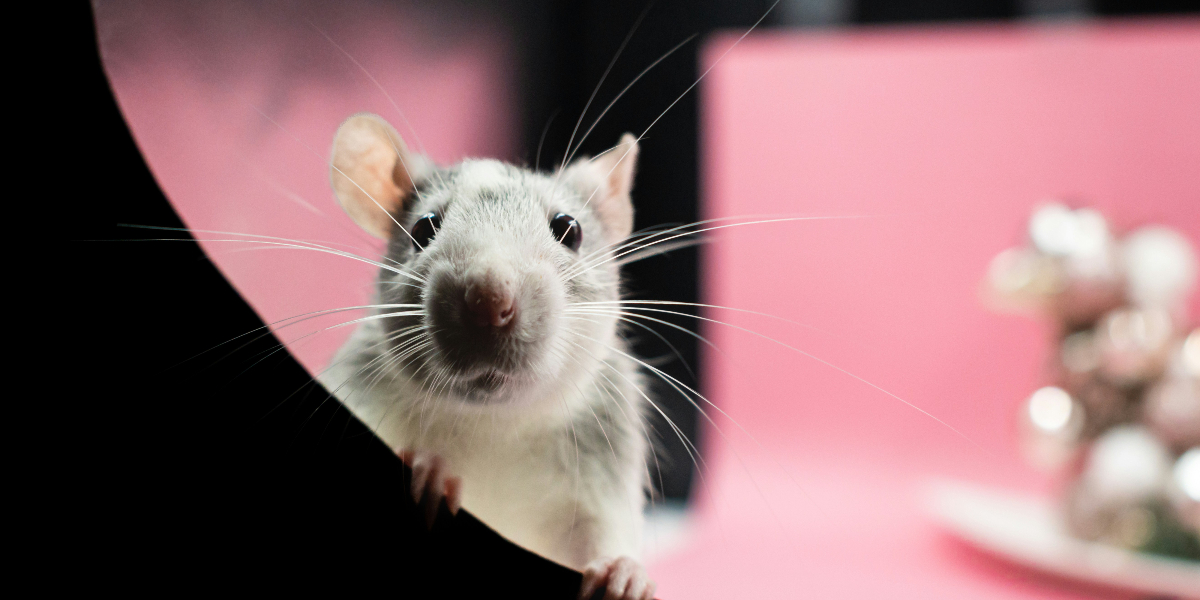Jon Adams is a former BBC New Generation Thinker and author of Interface Patterns: Literary Study, Scientific Knowledge, and Disciplinary Autonomy. He previously worked at the London School of Economics.
Edmund Ramsden is a historian of science and medicine at Queen Mary University of London. Before joining Queen Mary, he held posts at the universities of Manchester, Exeter, and London School of Economics.
Below, co-authors Jon and Edmund share five key insights from their new book, Rat City: Overcrowding and Urban Derangement in the Rodent Universes of John B. Calhoun. Listen to the audio version—read by Jon—in the Next Big Idea App.

1. Rats sort of practice birth control.
John Calhoun was an ecologist-turned-psychologist who, from the 1940s to the early 1980s, spent four decades investigating the link between crowding and behavior in rats, as well as humans.
Initially hired to counter a rodent infestation in postwar Baltimore, he discovered that rats were gregarious animals who formed complex, hierarchical societies. To more closely observe rodent society, Calhoun built an artificial city block, what he called a “rodent utopia,” where his animals would have their every need met—except space.
As population density in the “rat city” increased, crowding caused the rats to become stressed, and they began exhibiting increasingly severe behavioral problems. The highly ordered family units broke down, mothers neglected their young, and young males became violent and hypersexual.
Rats breed so rapidly that it’s theoretically possible to turn two rats into almost two thousand in a little over twelve months. But this sort of fertility never actually occurs in the real world. Calhoun wondered: why not?
Studying rats in Baltimore during the late 1940s, Calhoun discovered that population numbers were fixed at around 150 individuals per city block. While the residents were horrified by how many rats lived in the city, the ecologists were surprised that there were so few. 150 rats per block is much lower than the environmental resources permitted; in the downtown back alleys, there was no shortage of garbage to eat and plenty of places to nest.
“When social density increased, things began to fall apart.”
The population cap was robust: when a block’s rat population was reduced by poisoning or trapping, it soon bounced back but never exceeded the 150-rat limit. To Calhoun’s amazement, it seemed as if the rats were exercising their own form of birth control. But how?
Further investigation revealed rat society was held in a delicate balance, and raising pups past weaning required a surprising degree of domestic harmony. If a nursing mother is disturbed, she may attempt to relocate her young or abandon her nest and pups altogether. Under normal circumstances, a dominant male would stand guard to prevent nest invasions, but even the toughest kingpins would eventually be overwhelmed if the population grew too large.
So, when social density increased, things began to fall apart as squabbling destabilized family units, and ultimately caused reproductive rates in the over-populated area to decline until they settled back at the optimal level. The mysterious mechanism behind the spontaneous regulation of population size was discovered to be a limit imposed not by available food—but by available space. And, crucially, a habitat was “socially full” long before that space ran out.
2. Crowding is a communication (not proximity) problem.
When we think about crowding, we often think about the number of individuals in the same space. But it’s not just proximity that makes crowding unpleasant. Crowding is stressful not only because we are physically close but also because we might have to interact with those other individuals. It’s not so much physical contact we dread as social contact.
Luckily, we’re really good at ignoring each other. City dwellers become adept at the thousand-yard stare. On the daily commute, they studiously avoid making eye contact and certainly don’t make conversation. When everyone agrees to play along with this asocial contract, it creates a collective illusion of invisibility.
Rats, sadly, lack the ability to ignore one another. In the wild, when population density increased, rats would emigrate to a new habitat. But trapped inside his rat cities, Calhoun’s rodents soon found the frequency of social contact troublesome. Constantly obliged to greet other rats, measure their dominance ranking, and undertake an endless process of threat assessment, they became so harried by the social milieu that they lost their good manners and grew hostile. In time, that led to more severe behavioral problems, escalating violence, and population collapse.
Calhoun’s work with rats and mice made him realize humans’ remarkable capacity to avoid social obligations. This flair for voluntary social withdrawal made the growth of cities possible. While we often cite human communication genius as the secret to our success, learning how to ignore one another is just as important.
3. A good fence is a fence you can step over.
Robert Frost’s 1913 poem “Mending Wall” sees two neighbors at work repairing the dry stone boundary wall between their properties. As the poet questions why they need a wall at all, his neighbor stubbornly incants the old aphorism that “good fences make good neighbours.” It’s easy to imagine a good neighbor, but what’s a good fence?
“‘Good’ fences demarcate borders while allowing those on either side to communicate.”
In his early experiments, Calhoun divided his rat cities into separate cells using high walls topped with electric wires to strictly control which areas of the enclosure rats could move between. The rats became conditioned to cluster in a single cell, resulting in severe overcrowding, social breakdown, and brutal violence. In later experiments, these barriers were replaced with low dividers that the rats could step over but which—crucially—were sufficient to insulate them from unwanted contact.
A tall fence topped with electric wire is not a neighborly fence. “Good” fences demarcate borders while allowing those on either side to communicate. They are socially permeable. On at least the streetside of the property, a picket fence at waist- or even knee-height does the job. It signals a border and assumes the passerby is decent enough not to step over it. Any taller, and the fence tacitly presumes the intent to trespass.
In “Mending Wall,” Frost was skeptical of the need for a physical boundary at all. And yet, he was seemingly engaged in conversation with his neighbor the whole time they were repairing their low stone wall. Good neighbors make good fences.
4. More privacy isn’t always better.
Working in a remote Canadian mental institution in the 1950s, psychologists Robert Sommer and Humphry Osmond found that the cavernous open-plan wards were further unsettling their already disturbed inhabitants. An open space was more stressful than a closed cell. They discovered that simply by erecting folding screens and rearranging chairs, they could make the wards more peaceful. It was from this work that Sommer developed the concept of personal space. But while some degree of privacy was beneficial, it was possible to have too much.
In the 1970s, architect Oscar Newman borrowed from ecology the idea of territoriality and applied it to public housing. His theory of defensible space was intended to give residents in public housing a sense of ownership. But, instead, the focus on private territory and personal safety fostered suspicion and hostility. It was a logic that led to gated communities and billionaires building bunkers for the apocalypse.
Living in Boston’s West End in the early 1950s, sociologist Herb Gans learned: Have a stoop, a porch, a place to sit that bridges private and public. Building communal spaces builds community.
The same was true for rodents. Calhoun designed his later enclosures so there would be a central section where rats from different colonies might gather to socialize without trespassing on one another’s home turf. Being able to control the volume and frequency of social contact made life far less stressful for his rodents, and they lived longer and could endure higher population densities. Privacy is desirable, but its value does not increase with its quantity.
5. A rat is a symptom of bad housing, not a cause.
New York City’s Mayor Eric Adams recently appointed a “Rat Czar” to bring down the city’s rodent population, declaring: “I hate rats, and I’m confident most of our city’s residents do as well.” We vilify the rat as a totem of urban decay, but rats thrive only where care has been withdrawn.
“It turned out that the most enduring method of rat control was good property maintenance.”
In the 1940s, the City of Baltimore made a concerted effort to improve housing stock, and as they did so, the urban rodent population was drastically reduced. It turned out that the most enduring method of rat control was good property maintenance. Regular refuse collection, fixing broken pipes and fittings, and draft-proofing buildings prevented rats from inhabiting the same space as residents.
Bad buildings incubated rat colonies, and bad buildings led to social problems. As an activist chant from the 1960s put it: “RATS CAUSE RIOTS.” But the tail doesn’t really wag the dog, and you couldn’t solve the rioting simply by removing the rats.
Throughout his career, Calhoun remained adamant that eradicating rats was a purely cosmetic operation and that any program of rodent eradication would only achieve short-term success if the underlying structural problems were neglected.
As one colleague put it, “Rats are a symptom of bad housing, not a cause.” The rat was a sentinel species, its presence signaling that the infested neighborhood needed maintenance and repair. Hence, if your focus is on killing the rats, you’re really just shooting the messenger.
To listen to the audio version read by co-author Jon Adams, download the Next Big Idea App today:































